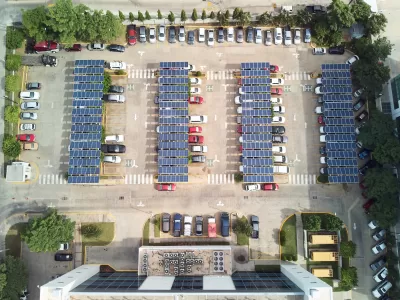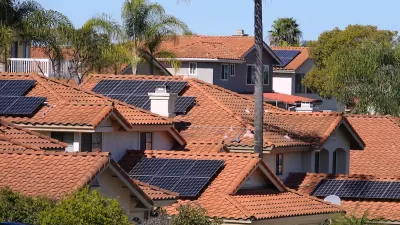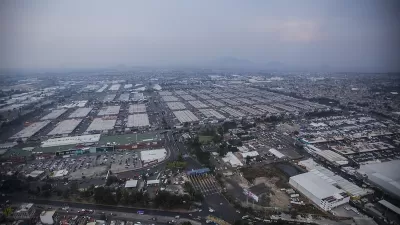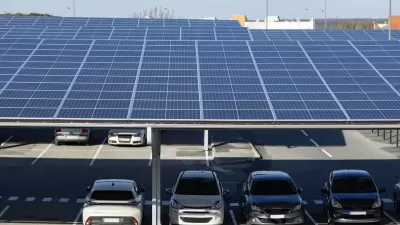Environmentalists are raising the alarm about massive solar farms in the unspoiled desert. Why not install more solar panels along state-owned highways and in parking lots instead?

In an editorial published last week, the Los Angeles Times Editorial Board calls on California leaders to “think creatively and find ways to put more solar energy in already built-out places, including rooftops and parking lots, canals and agricultural fields, so we can slow the climate crisis without harming sensitive land, like the habitat of threatened Joshua trees or Mojave Desert tortoises.”
And because of California’s high power costs and extensive road network, using highway right-of-way could make a major impact: “A 2020 study by University of Texas at Austin researchers found that because of California’s high electricity rates, it could generate more revenue than any other state from placing solar along its highway interchanges, more than $300 million a year.”
The board supports Senate Bill 49, state legislation introduced by state Sen. Josh Becker (D—Menlo Park), which would require the state to plan for installing solar panels along “underutilized” portions of right-of-way adjacent to state highways. “Senate Bill 49 would start to unlock the potential along California’s 15,000 miles of state highways, by giving Caltrans about two years to develop a plan to lease state-owned rights-of-way to utility companies or private developers to install solar panels, battery storage and transmission lines.”
The bill, which was passed unanimously by the Transportation Committee, includes financial incentives for property owners such as schools, businesses, and multifamily housing developments that would make it less costly to install solar parking lot canopies.
For the editorial board, “This idea should be a no-brainer for lawmakers.”
The proposal would follow in the footsteps of other states, including Oregon, Georgia, and Massachusetts, that have created similar programs, and countries like France, which recently mandated solar canopies on all parking lots with more than 80 spaces. “It just makes sense, economically and environmentally, to concentrate solar projects in areas that are already developed, especially if they are near cities, factories or other locations where there’s already demand for electricity,” the board writes.
FULL STORY: Editorial: California needs a lot more solar. Why not put panels along highways and parking lots?

Study: Maui’s Plan to Convert Vacation Rentals to Long-Term Housing Could Cause Nearly $1 Billion Economic Loss
The plan would reduce visitor accommodation by 25,% resulting in 1,900 jobs lost.

North Texas Transit Leaders Tout Benefits of TOD for Growing Region
At a summit focused on transit-oriented development, policymakers discussed how North Texas’ expanded light rail system can serve as a tool for economic growth.

Why Should We Subsidize Public Transportation?
Many public transit agencies face financial stress due to rising costs, declining fare revenue, and declining subsidies. Transit advocates must provide a strong business case for increasing public transit funding.

How Community Science Connects People, Parks, and Biodiversity
Community science engages people of all backgrounds in documenting local biodiversity, strengthening connections to nature, and contributing to global efforts like the City Nature Challenge to build a more inclusive and resilient future.

Alabama: Trump Terminates Settlements for Black Communities Harmed By Raw Sewage
Trump deemed the landmark civil rights agreement “illegal DEI and environmental justice policy.”

Dear Tesla Driver: “It’s not You, It’s Him.”
Amidst a booming bumper sticker industry, one writer offers solace to those asking, “Does this car make me look fascist?”
Urban Design for Planners 1: Software Tools
This six-course series explores essential urban design concepts using open source software and equips planners with the tools they need to participate fully in the urban design process.
Planning for Universal Design
Learn the tools for implementing Universal Design in planning regulations.
City of Santa Clarita
Ascent Environmental
Institute for Housing and Urban Development Studies (IHS)
City of Grandview
Harvard GSD Executive Education
Toledo-Lucas County Plan Commissions
Salt Lake City
NYU Wagner Graduate School of Public Service





























